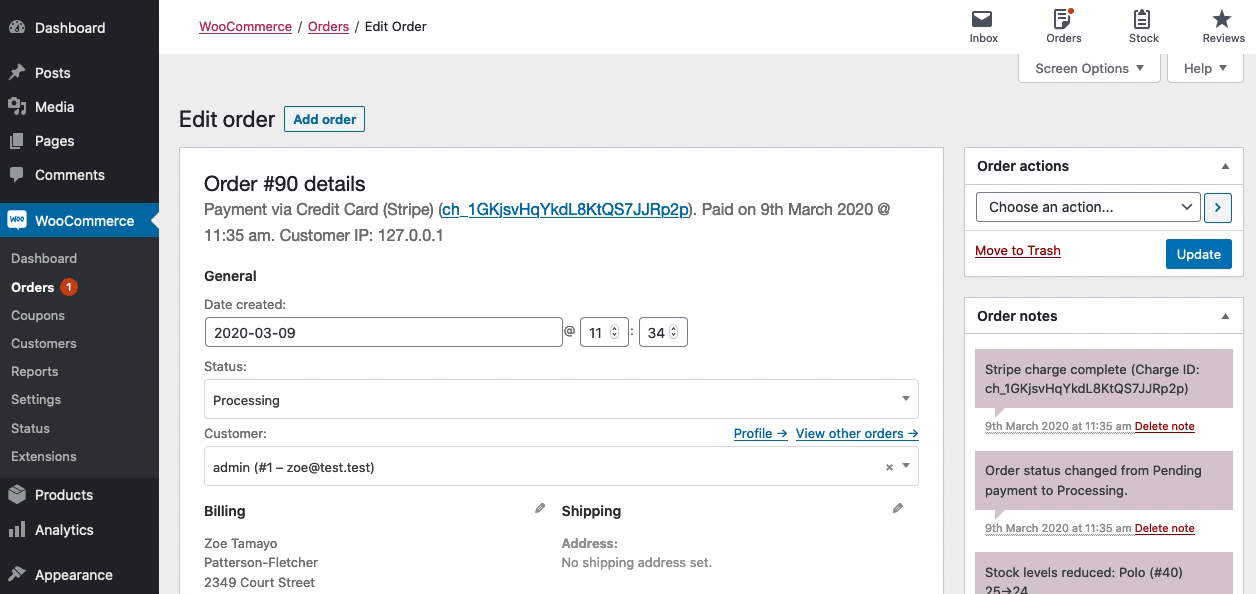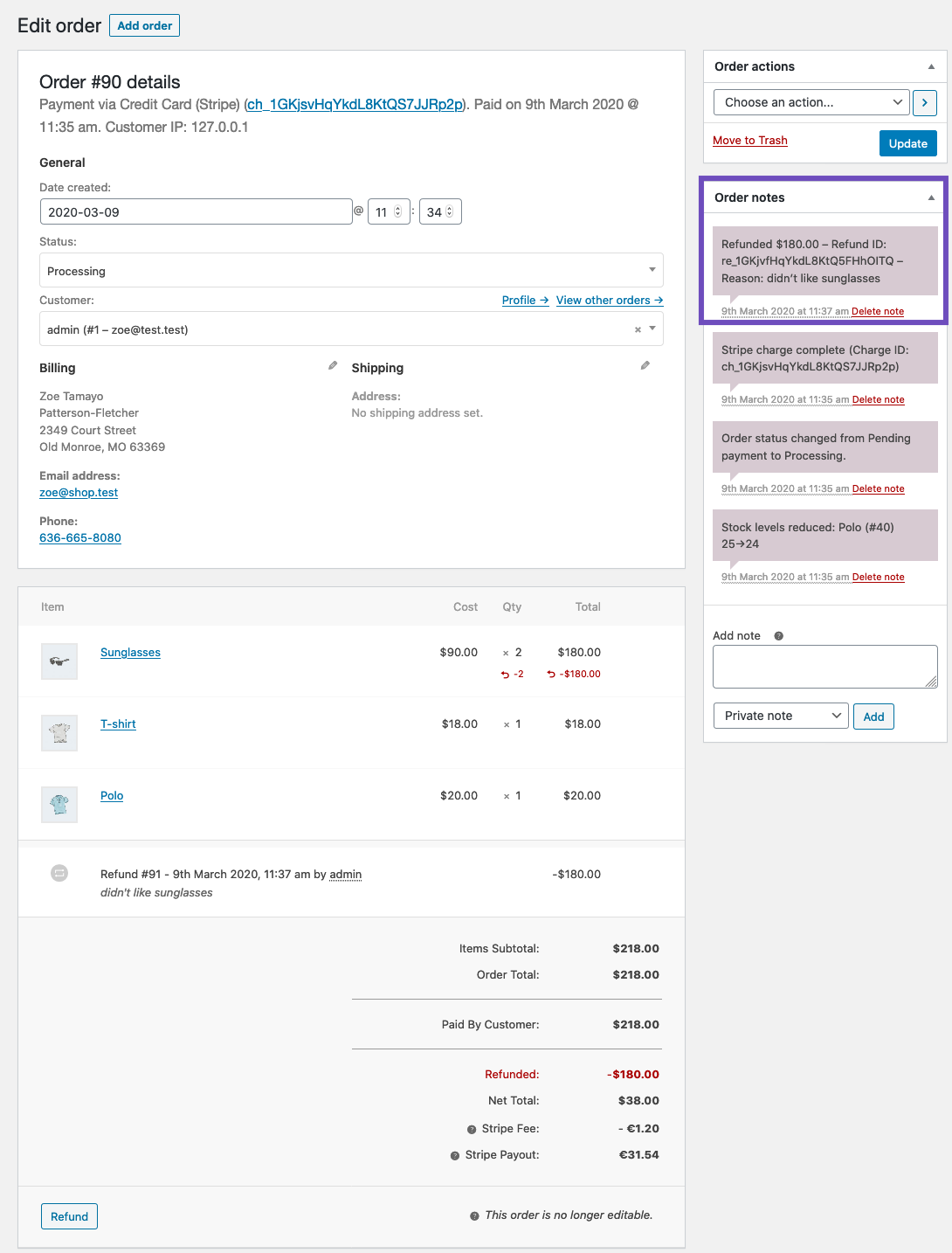WooCommerce Refunds
Summary
In WooCommerce itself you can process refunds in two ways:
- Automatic: Refunds change the WooCommerce order status and also reverse the charge so your customer gets their money (jump to section).
- Manual: Refunds change the WooCommerce order status, but you need to return the money manually to your customer (jump to section).
Automatic Refunds
These are called Automatic refunds as when you process refunds that are connected to your payment gateway. Once you’ve processed this type of refund in your WooCommerce Admin, no further actions are necessary.
- Check: Review the documentation or support of your payment gateway on whether automatic refunds are available. Most automatic payments fully support this.
- Scope: Refunds normally extend to products, taxes, and shipping fees. However, transaction fees charged by the payment gateway will likely be lost and not refunded.
- Setup: Make sure that your API settings are set and test your payment gateway and refunds while in sandbox or test mode:

- WooCommerce: Refunds and can be processed through the Orders:
- Go to: WooCommerce > Orders.
- Select the order to refund.
- Go to the order summary, and select “Refund” to start.
- Specify the quantity of the product(s) to be refunded in the text box(es) that appear for each line item. The refund amount will automatically adjust based on the products refunded. If inventory levels are not managed, you can also enter the Refund amount, without adjusting the product quantity.
- If the quantities of items are not set when issuing a refund then the order is not marked as refunded and the email that is sent will say “partial refund.”
- Add refund notes, if desired.
- Select “Refund $XX.XX via [your gateway]”.

How Do I Know It Worked?
Order Notes in the right sidebar will log refunds. Keep an eye on the order notes to learn if it’s been logged or if there’s an error message. A successful “Refunded” message in order notes concludes the refund.

Manual Refunds
- Check: Consult the documentation or support of
your payment gateway on whether manual refunds are available. You will
either need to:
- Log in to your payment method account and process the refund there.
- Transfer the money from your bank account manually.
- Scope: Refunds normally extend to products, taxes, and shipping fees. However, transaction fees charged by the payment gateway will likely be lost and not refunded.
- WooCommerce: Refunds and can be processed through your Orders page. To manually refund an order:
- Go to: WooCommerce > Orders.
- Select the order to refund.
- Go to the order summary, and select “Refund” to start.
- Specify the quantity of the product(s) to be refunded in the text box(es) that appear for each line item. The refund amount will automatically adjust based on the products refunded. If inventory levels are not managed, you can also enter the Refund amount, without adjusting the product quantity.
- If the quantities of items are not set when issuing a refund then the order is not marked as refunded and the email that is sent will say “partial refund.”
- Add refund notes, if desired.
- Select “Refund $XX.XX manually”.

Items selected for a refund will be noted as refunded. Once the refund has been applied to the order, it will look like this:

Restocking Products Based on Refunds
When processing a refund, you have the option to restock products by ticking the “Restock refunded items” box:

FAQs
How do I find out if my payment gateway is refund-compatible?
- Check the documentation of the payment gateway.
- Buy the plugin and give it a try. We have a 30-day Money Back Guarantee and can refund you with no hassle.
- Check with the payment gateway provider.
- Ask us.
I am a developer. How do I find out if my payment gateway is refund-compatible?
Go to How to check if your payment gateway supports refunds and look up class constructor class properties.
Related Articles
WooCommerce Reports
Reports in WooCommerce give you the ability to see your store’s performance from month to month using graphs and stats. It has four sections: Orders, Customers, Stock, and Taxes. With the release of WooCommerce 4.0, these reports are becoming ...WooCommerce Analytics
WooCommerce Analytics only works with WordPress 5.3+. WooCommerce Analytics is a new reporting and data analysis tool to help you manage your WooCommerce Store. The suite introduces nine new reports along with advanced filtering and segmenting tools, ...Managing Orders
Orders are created when a customer completes the checkout process, and they are visible to users with Admin and Shop Manager roles only. Each order is given a unique Order ID. Order IDs are non-sequential as they use the default WordPress ID ...Adding Product Images and Galleries
Images are measured and set in pixels, for example, 800 x 800 pixels. Note that the first number is the width and the second is height. We recommend organizing your images in a folder offline and keeping a backup in case you need them in the future ...Digital/Downloadable Product Handling
Setup and Configuration Go to: WooCommerce > Settings > Products > Downloadable Products. Select a File Download Method from the dropdown. Force Downloads – File downloads are forced, using PHP. To ensure files are protected from direct linking, ...